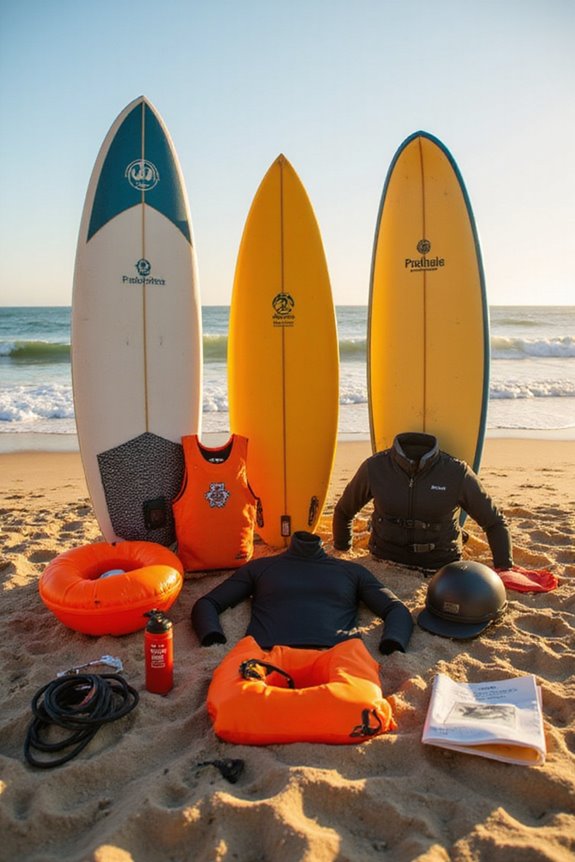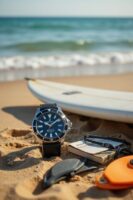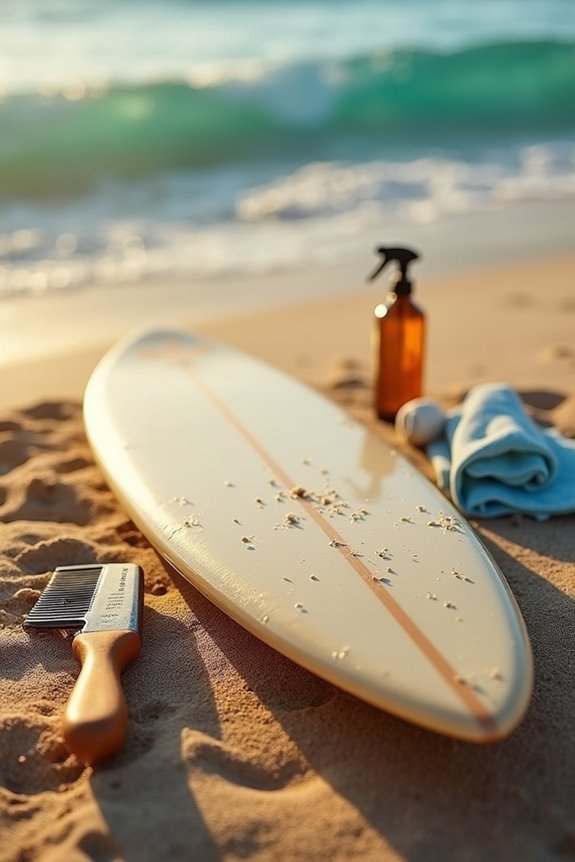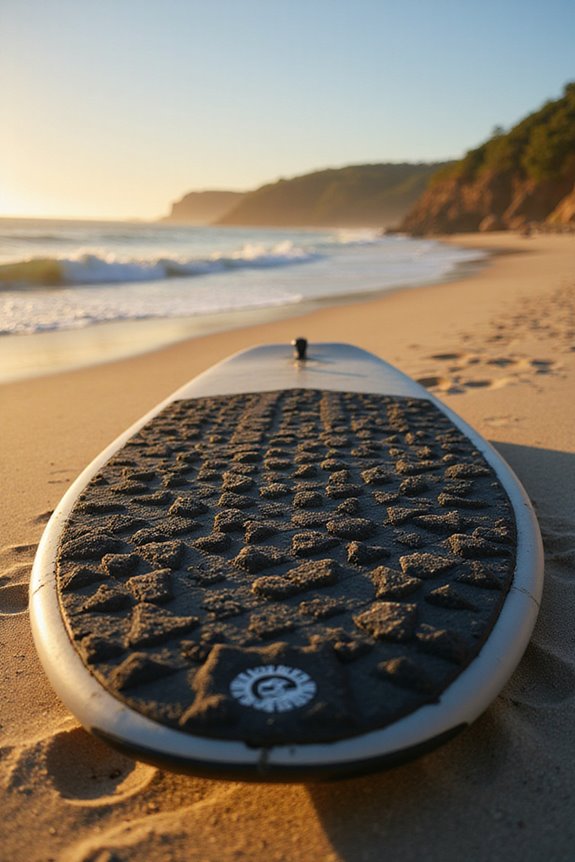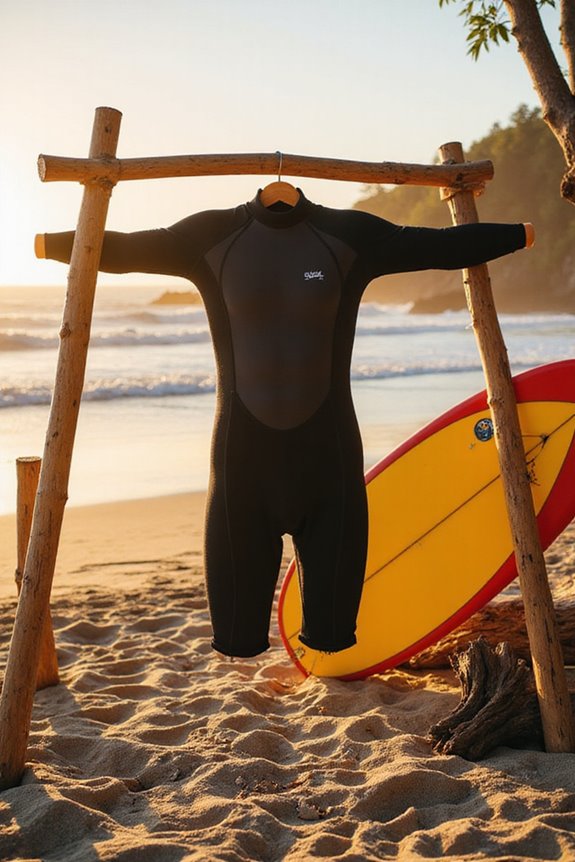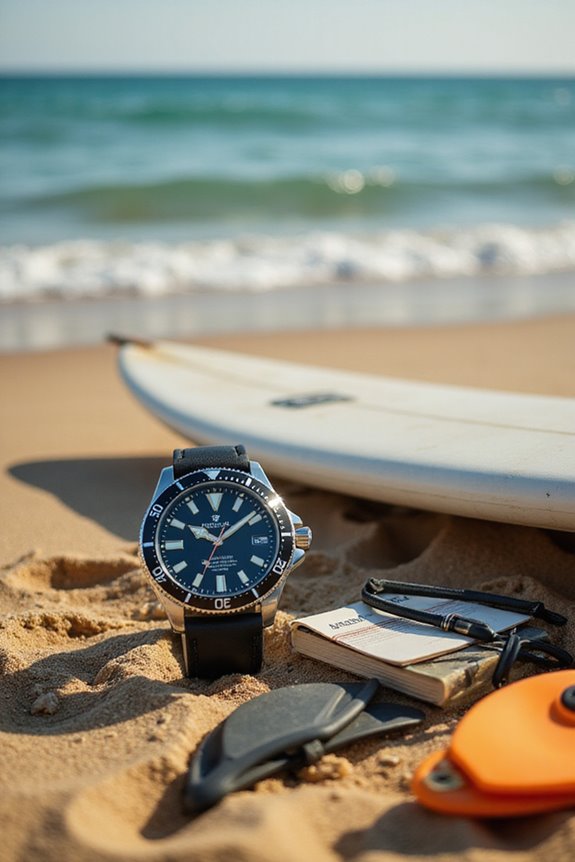To stay safe while surfing, we should start by understanding hazards like rip currents and board collisions. Choosing the right gear is essential; beginners need longer, softer boards, while more experienced surfers opt for shorter boards. We must also stay alert to our surroundings, avoid crowded areas, and check weather conditions before entering the water. Learning proper emergency responses and respecting marine life enhances our safety. By focusing on these factors, we can greatly improve our surfing experience. More information awaits to deepen our understanding.
Key Takeaways
- Always be aware of your surroundings, including other surfers and potential hazards like rocks or rip currents.
- Use appropriate surfing gear, such as a soft-top board for beginners and a properly fitting wetsuit for comfort and warmth.
- Surf with a buddy to enhance safety and ensure help is available in emergencies.
- Regularly check weather conditions and surf reports to avoid dangerous situations.
- Familiarize yourself with local marine life and practice calm, controlled movements if you encounter any creatures.
Understanding Surfing Hazards
When we hit the waves, it’s crucial to recognize the various hazards that can lead to injuries or more serious incidents. The most common injury mechanism involves board-to-body collisions, accounting for about 22.4% of injuries. Additionally, impacts with the sand and our own surfboards contribute considerably to injury rates.
To improve injury prevention, we must remain aware of our surroundings. This includes potential collision risks with other surfers and stationary objects like rocks. Environmental factors, such as rip currents and steep sea floors, can also pose threats. By understanding these risks, we can make informed choices about where and how we surf, ultimately enhancing our safety on the water. Wearing a helmet that complies with safety standards can further protect against head injuries in case of unexpected falls or impacts.
Preparing Proper Surfing Gear
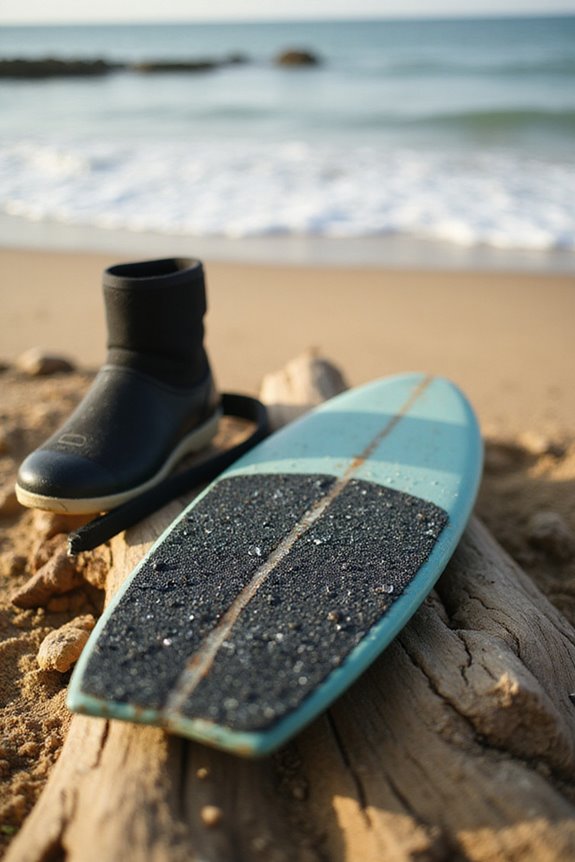
To guarantee a safe and enjoyable surfing experience, we need to select the right gear tailored to our individual needs and the conditions we’ll encounter.
Surfboard Selection
Choosing the right surfboard is vital. Beginners should opt for longer, wider, soft-top boards (around 8-9 feet) for stability, while advanced surfers might prefer shorter, performance-focused boards. Foam surfboards are ideal for beginners due to their reduced injury risk. Boards with buoyant designs enhance balance and make wave catching easier for new surfers.
Wetsuit Fit
A properly fitting wetsuit is essential for warmth and comfort in colder waters. We should choose the thickness based on water temperature and our individual tolerance. Common materials include neoprene, available in thicknesses from 2mm to 5mm. Finding the right fit will help maintain insulation and allow freedom of movement.
Safety Practices in the Water
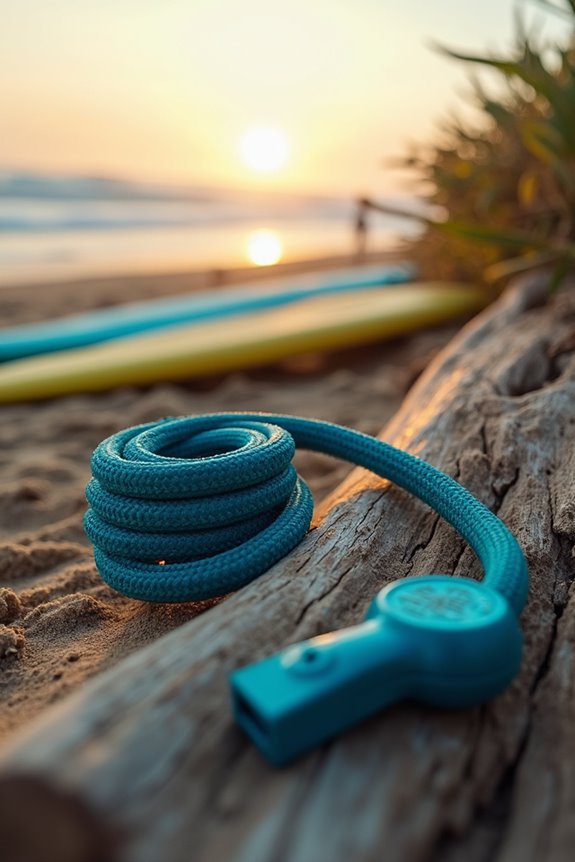
Understanding water safety practices is vital for anyone who enjoys surfing. We should always be aware of our surroundings, especially recognizing hazards like rip currents, which can pull us away from shore unexpectedly. Surfing with a companion can greatly enhance our safety, as they can assist in emergencies.
Before heading out, we should check the weather conditions to guarantee safe surfing conditions. Additionally, regular surfboard maintenance is essential; a well-maintained board is less likely to fail when we need it most. Finally, we must prioritize surfing at lifeguard-patrolled beaches. Lifeguards provide critical surveillance and can notably reduce the risk of drowning. By following these practices, we can enjoy the waves more safely. Moreover, using a surfboard leash can ensure that your board stays close to you, minimizing the chances of injury in turbulent waters.
Physical and Skill Preparation
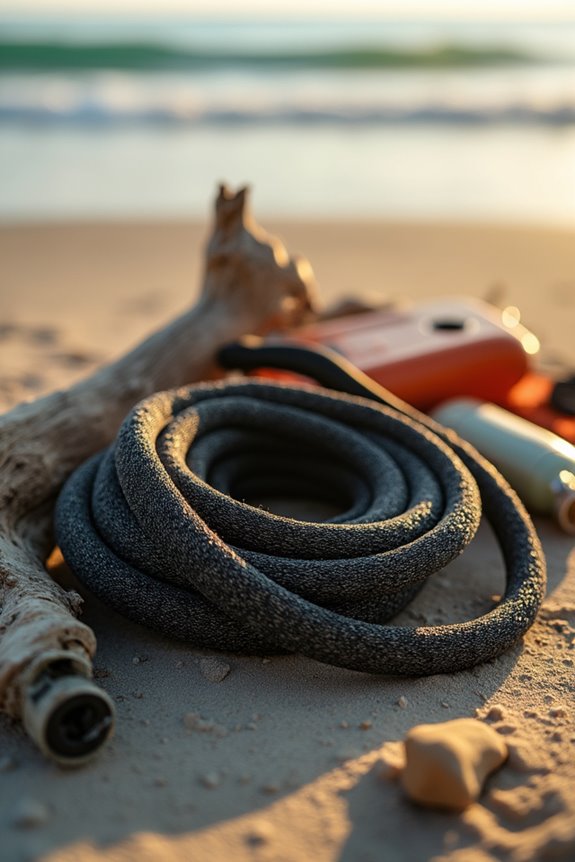
Building on our awareness of safety practices, physical and skill preparation plays a significant role in enhancing our surfing experience. Engaging in fitness training is essential; we should focus on cardiovascular endurance, strength training, and flexibility. Activities like swimming, running, and cycling improve our lung capacity and paddling muscles.
Strengthening our upper and lower body through exercises such as push-ups, squats, and dumbbell rows enhances our paddling power.
To improve balance, we can incorporate core stability exercises like planks and rotational movements, which are imperative for maneuvering on the board. Regularly practicing surfing in different conditions also aids in skill development, helping us adapt to the physical demands of the sport and improving our overall performance in the water. Additionally, incorporating yoga poses for surfers into our routine can enhance flexibility and core strength, which are crucial for maintaining balance on the board.
Environmental and Local Awareness
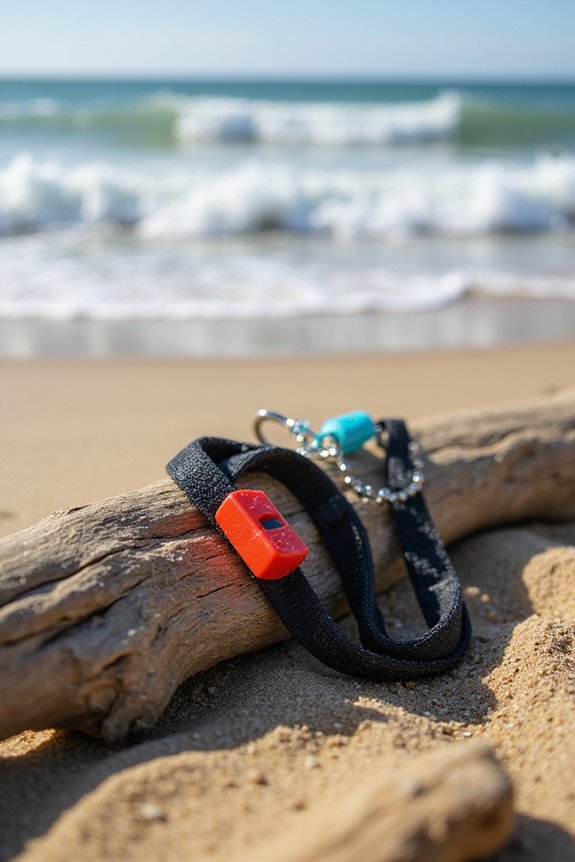
As we venture into the waves, it’s crucial to recognize the importance of our local coastal ecosystems. About 75% of the world’s surf breaks thrive in biodiverse marine environments that need careful attention and understanding. To protect these ecosystems, we can engage in conservation practices like participating in beach cleanups, monitoring water quality, and supporting local restoration projects. Additionally, understanding the wave conditions and seasons can help us choose the best times to surf while minimizing our impact on these environments. We should also be aware of local flora and fauna, avoiding actions that might disturb marine life or damage coral reefs. By partnering with organizations like Save The Waves Coalition, we can help protect essential surf ecosystems. Together, we can make sure that our surfing experiences do not harm the environments we cherish and enjoy.
Emergency Preparedness and Response
How can we guarantee our safety while enjoying the surf? One effective way is through proper rescue training and participation in emergency drills. Surfers with formal training are three times more likely to provide first aid during emergencies. By honing our skills in rescue techniques and communication, we can enhance our effectiveness in surf rescues.
It’s essential to have a coordinated approach, involving on-shore spotters and trained rescue teams. When emergencies arise, strong communication—such as hand signals—helps direct resources efficiently. Additionally, developing evacuation plans for large surf sessions ensures swift access to medical assistance. With over 80% of surfers having assisted in rescues, we must be prepared to act responsibly and confidently when needed. Furthermore, participating in surfing lessons can enhance our understanding of safety measures and ocean dynamics.
Recognizing and Managing Rip Currents
Recognizing and managing rip currents is essential for our safety while enjoying the surf. Rip current identification involves looking for choppy water, a gap in breaking waves, or debris moving seaward. Understanding these signs helps us avoid dangerous situations.
If we find ourselves caught in a rip current, it’s vital to stay calm. Instead of swimming against it, we should use rip current strategies like swimming parallel to the shore to escape. If we can’t break free, treading water or floating helps conserve energy while signaling for help. Remember, rip currents eventually lose strength, and with the right approach, we can safely return to the beach. Always prioritize safety and awareness when enjoying the ocean.
Maintaining Surf Etiquette
Maintaining surf etiquette is essential for ensuring a safe and enjoyable experience for everyone in the water. To promote surfer respect, we should always observe wave priority. The surfer closest to the wave’s peak has the right of way, so let’s be patient and avoid dropping in on others.
Effective wave communication is vital; signaling our intentions helps prevent collisions. We must also avoid “snaking,” which undermines the lineup’s harmony. When paddling back, we should do so wide of breaking waves to minimize interference.
Additionally, let’s treat others as we wish to be treated, respecting locals and established surfers. If we accidentally breach etiquette, saying “Sorry” can help maintain good relations and a positive surf environment.
Responding to Marine Life Encounters
When we enjoy surfing, it’s important to be aware of the marine life that inhabits our local waters. Understanding common species and their behavior can help us navigate potential marine encounters safely. We should maintain a respectful distance from marine animals, avoiding actions that could provoke them, like touching or chasing.
If we encounter a marine creature, staying calm and avoiding sudden movements helps reduce the perceived threat. Using our surfboard as a stable platform allows us to maintain balance. If a potentially dangerous animal is nearby, we should slowly exit the area without splashing. Finally, we must always stay informed about local marine life and adhere to safety guidelines to guarantee a safe surfing experience.
Frequently Asked Questions
What Are the Best Surf Spots for Beginners?
When exploring beginner-friendly beaches, we recommend checking out surf schools in places like Ericeira or Waikiki. These spots offer consistent waves and supportive environments, making it easy for us to learn and enjoy surfing together.
How Can I Improve My Surfing Skills Quickly?
To improve our surfing skills quickly, we should focus on refining surfing techniques through consistent practice drills. Incorporating paddling, pop-ups, and balance exercises will enhance our overall performance and help us ride waves more effectively.
What Should I Eat Before Surfing?
What’s the best way to fuel our surfing sessions? We should choose energy-boosting foods like banana chia pudding or whole-grain toast as pre-surf snacks, ensuring we have sustained energy for those waves.
How Do I Choose the Right Surfboard Size?
When choosing a surfboard, we should consider surfboard types and sizing guidelines. Beginners often benefit from longer boards for stability, while intermediate and advanced surfers might prefer shorter, more maneuverable options tailored to their weight and skill level.
Can I Surf During a Thunderstorm?
We’ve all felt the thrill of catching waves, but we can’t ignore thunderstorm risks. Lightning safety is essential; it’s best to avoid surfing during storms to protect ourselves from unexpected strikes and serious harm.

